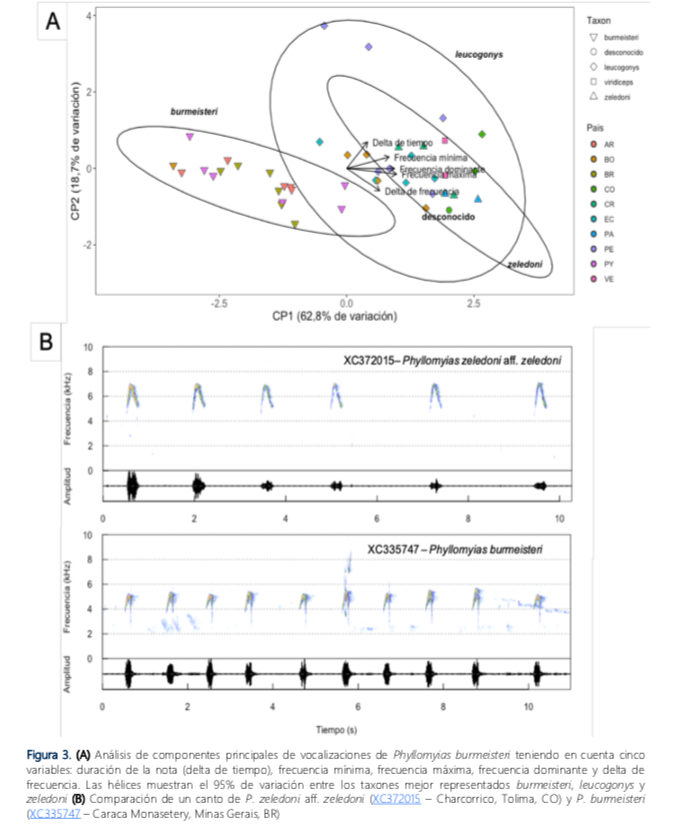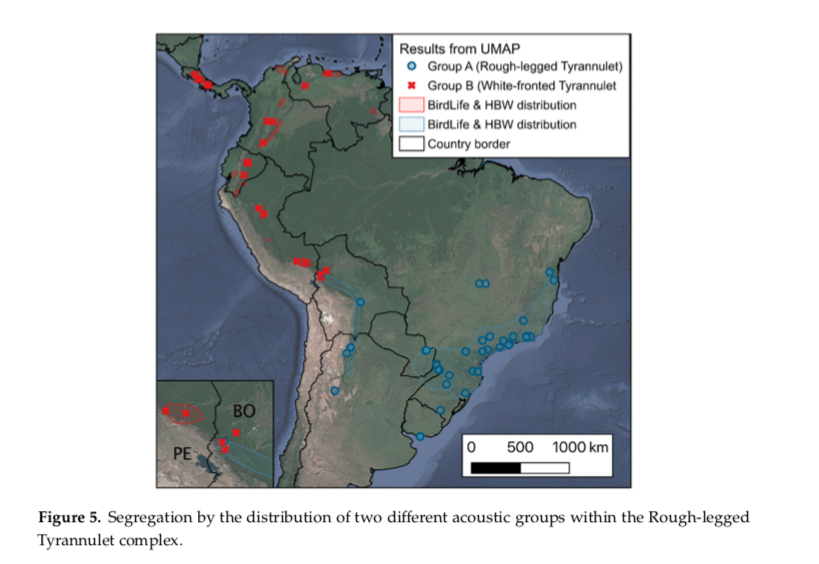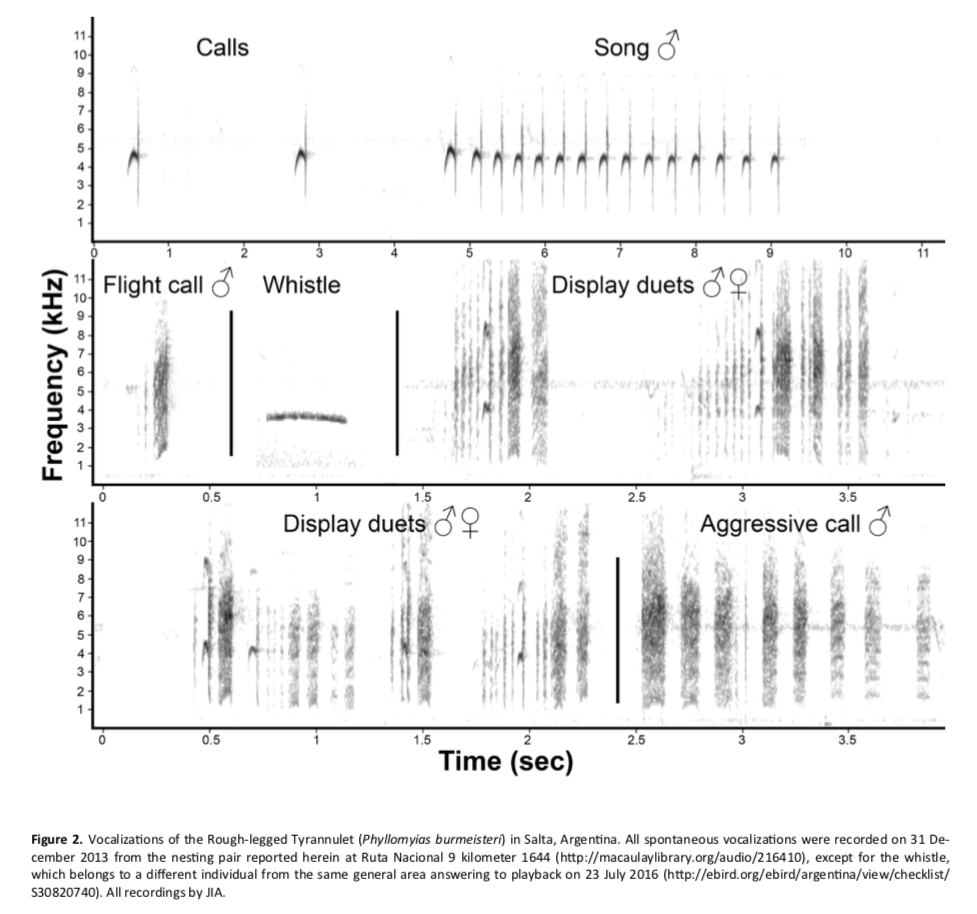Proposal (962) to South
American Classification Committee
Species
limits and generic placement of Phyllomyias
burmeisteri and the generic limits
of Tyranniscus
Our
current SACC notes state:
"2. Although Fitzpatrick (2004) followed Traylor's (1977,
1979a) broad definition of Phyllomyias, he
noted that this genus is likely polyphyletic, with P. fasciatus, P.
griseocapilla, and P. griseiceps possibly forming a group unrelated
to the other species, which would force minimally the resurrection of Tyranniscus
(see Note 6).
2a. The species
burmeisteri was formerly (e.g., Cory & Hellmayr 1927, Pinto 1944, Meyer de Schauensee 1970) separated in
the genus Acrochordopus based on tarsal morphology, but Acrochordopus
was merged into Phyllomyias by Traylor (1977, 1979a). Acrochordopus
was considered to belong in the Cotingidae by Ridgway (1907) and Wetmore &
Phelps (1956). The name Idiotriccus was formerly (e.g. Ridgway
1907) used for Acrochordopus.
2b. Wetmore (1972),
Stiles & Skutch (1989), Sibley & Monroe (1990), Ridgely & Tudor
(1994), and Ridgely & Greenfield (2001) recognized the northern subspecies
zeledoni as a separate species from Phyllomyias burmeisteri based on
described vocal differences; this treatment returns to earlier ones (Cory &
Hellmayr 1927, Zimmer 1941c, Phelps & Phelps 1950a) that treated the two as
separate before Meyer de Schauensee's (1966, 1970) and Traylor's
(1977<?>, 1979a) classifications. Stiles & Skutch (1989) further recognized
Andean birds as a separate species, P. leucogonys, from Central American
P. zeledoni, returning to the classification of (REF). Elevation of
these taxa to species rank was not followed by Fitzpatrick (2004) due to lack
of published analyses of vocal differences or other data. SACC proposal needed.
6. The species nigrocapillus,
cinereiceps, and uropygialis were formerly (e.g., Ridgway 1907,
Cory & Hellmayr 1927, Zimmer 1941b, Phelps & Phelps 1950a, Meyer de
Schauensee 1970) placed in a separate genus, Tyranniscus, but they were
transferred to Phyllomyias by Traylor (1977, 1979a). <check gracilipes
-- in Tyranniscus in Pinto 1944>
"
Species
limits:
Parra-Hernández et al. (2020a, b) performed acoustic analyses to
understand vocal variation in P.
burmeisteri. Their results support the recognition of two vocal clusters.
Figure 3 in Parra-Hernández
et al. (2020a) shows spectrograms and a PCA.

Figures 3-5 in Parra-Hernández et al. (2020b) show
the geographic distribution of data points analyzed, together with different
analyses performed in order to try to group the different vocal types. Note
here that according to these results, leucogonys
would fall within the spectrum of variation of zeledoni.


Areta et al (2021) showed some other vocalizations, and
discriminated between calls and song of burmeisteri.
Clearly, there is more to be done in vocal analyses. Notably, burmeisteri has a "two-noted" song repeated in quick succession
(sometimes given at dawn, so perhaps a dawn song...), which might also be
profitably compared to the northern taxa (e.g., this leucogonys recording).

Herzog et al (2016) indicated that in W La
Paz, the taxon present belongs to the zeledoni
group, and they provided separate vocal descriptions for both groups. See for
example here for a song of burmeisteri from Santa Cruz sounding like birds in NW
Argentina and in the Atlantic Forest of Argentina, Brazil and Paraguay, and the
different sounding leucogonys from La Paz. It seems that the two vocal types
are geographically segregated, although the exact turnover point needs further
elucidation. Compare against for example this song of viridiceps the Coastal Cordillera in Venezuela.
There
are three main species-limits options here:
A) One
species treatment: keep all taxa in a wide-ranging P. burmeisteri (this is our current treatment). There is not much
support for this treatment, although one could argue that the vocal
differences, even if diagnostic, are not outstanding. The gap in information in
CN Bolivia could create concern, as if there will be vocally intermediate
individuals, they would come from this area. However, the vocal equivalency
between Atlantic Forest and allopatric Andean birds in the burmeisteri group, may signal that the divergence between leucogonys and burmeisteri is real and could undermine the idea of the existence
of intermediate individuals.
B) Two
species treatment: split P. zeledoni including
wetmorei, viridiceps, bunites,
together with leucogonys from P. burmeisteri. This is the option
supported by vocal analyses in Parra-Hernandez et al. 2020 (a,b).
C) Three
species treatment: split P. zeledoni, P. leucogonys and P. burmeisteri. I would like to hear from those with more
experience with zeledoni and leucogonys on whether they agree with
their treatment as the same species. This would also mean that we need to
decide on which of the South American taxa stay with zeledoni and which are more properly placed with leucogonys.
2) Generic
placement
Regarding the generic placement, Areta et al (2021) discussed
different alternatives following the tree of Harvey et al (2020) and nesting
data:
Phylogenetics
of Phyllomyias and nest structure
The genus Phyllomyias, as currently composed, is clearly
polyphyletic and four groups can be distinguished (Ohlson et al. 2008, Tello et
al. 2009, Harvey et al. 2020). The first group includes the type species of Phyllomyias,
P. fasciatus, which is closely related to the Sooty-headed (P.
griseiceps) and Yungas (P. weedeni) Tyrannulets, forming a clade
sister to Phaeomyias-Nesotriccus (Ohlson et al. 2008, Tello et al. 2009,
Herzog et al. 2012, Harvey et al. 2020). Nests are small cups covered with
lichens for the former two species, yet undescribed in the latter (Belton 1985,
Gonzaga and Castiglioni 2007, R. Ridgely in Hilty and Brown 1986).
The fourth group includes P. burmeisteri (nominate and zeledoni
as sister), the Black-capped (P. nigrocapillus; type of the genus Tyranniscus,
see Cabanis and Heine 1859), Tawny-rumped (P. uropygialis), and
Ashy-headed (P. cinereiceps) tyrannulets. This clade is sister to Ornithion-Camptostoma
(Tello et al. 2009, Harvey et al. 2020). The genetically unsampled but
distinctive leucogonys would presumably be more closely related to burmeisteri
and zeledoni. At the generic level, one alternative would be to treat
all four species in the genus Tyranniscus, whilst P. burmeisteri (together
with zeledoni and possibly leucogonys) might alternatively be put
in the genus Acrochordopus Berlepsch and Hellmayr 1905 (type species Phyllomyias
subviridis Pelzeln 1871, a junior synonym of burmeisteri,
see Hellmayr 1914, 1927). The open cup of burmeisteri and zeledoni contrasts
with the globular nests of Camptostoma and Ornithion (Narosky
& Salvador 1998, de melo Dantas 2006, de la Peña 2016). Unfortunately, no
data is available on the nesting of P. nigrocapillus, P. uropygialis,
or P. cinereiceps (Crozariol 2016). "
Here is the tree from Harvey et al (2020):

Keeping burmeisteri and
allies in Phyllomyias is not a viable
alternative, although fixing this won´t make Phyllomyias monophyletic (which requires several changes, but this
is a separate issue).
There are two solid options that we could embrace to begin
untangling the generic limits:
A) Broad Tyranniscus: put burmeisteri (including all the taxa
historically contained within it, whether at the species or subspecies level), cinereiceps, nigrocapillus and uropygialis
in Tyranniscus. This option creates a
diverse Tyranniscus, with
genetically, vocally and morphologically quite divergent species.
B) Narrow Acrochordopus: put burmeisteri in Acrochordopus. This seems the conservative option. The rough tarsus
of burmeisteri sensu lato is often
visible even in the field (it does stand out), the genus has been used frequently
in the past, and the taxa in the group are closely knit.
3) Spinoff
on Tyranniscus: If 2B
passes, then we could also move forward and put cinereiceps, nigrocapillus
and uropygialis in Tyranniscus as done well before the
genomic era or the massive Phyllomyias
lump by Traylor (see SACC note 6 above). The three taxa are closely related and
share their high-pitched and similarly patterned vocalizations with a flatter
initial note and some sort of rapid chatter. Although cinereiceps is more different in terms of plumage and was sister to
the other two, it is vocally very similar to nigrocapillus.
Recommendations: we
recommend YES to 1B (depending on discussions on the zeledoni/leucogonys conundrum) and YES to 2B. Likewise, we
recommend a YES to 3.
Voting:
1. Species Limits: Pick
A, B, or C. If one of the options
doesn’t get at least a 7-3 majority on first ballot, then we will do something
more complex.
2. Generic placement:
Pick A or B. Ditto on subsequent ballots
if needed.
3. Tyranniscus
expansion: If you voted for B, then YES or NO on this one
References:
Areta,
J.I., Mangini,
G.G., Gandoy, F.A. & M. Pearman. 2021. Notes on
the nesting of the Rough-legged Tyrannulet (Phyllomyias
burmeisteri): phylogenetic comments and taxonomic tracking of
natural history data. Ornitologia Neotropical 32:56-61.
Parra-Hernández, RM & HD Arias-Moreno (2020a)
Primer registro de Phyllomyias burmeisteri para la cordillera Central de los Andes colombianos, con
comentarios en su variación acústica. Ornitología Colombiana 17: eNB10.
Parra-Hernández, RM, JI
Posada-Quintero, O Acevedo-Charry & HF Posada-Quintero (2020b) Uniform
Manifold Approximation and Projection for clustering taxa through vocalizations
in a Neotropical passerine (Rough-Legged Tyrannulet, Phyllomyias burmeisteri).
Animals 10: 1406.
J. I. Areta & M. Pearman, February 2023
Comments from Lane:
“Part 1: YES to option B,
recognizing burmeisteri and zeledoni as separate species.
“Part 2: YES to option B,
recognizing Acrochordopus for burmeisteri and zeledoni.
“Part 3: YES to recognizing Tyranniscus
for nigriceps, uropygialis, and cinereiceps.”
Comments
from Stiles:
“Species-limits options- A- NO to keeping all in burmeisteri; B- YES to
separating burmeisteri from the leucogonys-zeledoni group;
C- NO for further split of leucogonys and zeledoni on the basis
of vocal data; at least, genetic data needed. (I´m at a bit of a loss here,
because 1A and 1B are mutually exclusive options and in effect recommending
both is confusing). 2. Generic-level options- A- a broad Phyllomyias-NO: at the
least, the Acrochordopus group must be split off; B- Split off the Acrochordopus
group of burmeisteri et al-YES; 3. Spinoff from Tyranniscus
(i.e., resurrect Tyranniscus for nigricapillus et al. leaving the rest
(fasciatus et al.) in Phyllomyias- YES. Thus, the result would be three
genera, no?”
Comments
from Zimmer:
“Part
1. YES on Option B: Two species
treatment, splitting P. zeledoni (including wetmorei, viridiceps,
bunites & leucogonys) from P. burmeisteri, following the vocal
analyses in Parra-Hernandez et al. 2020.
I still think there remains the possibility that more comprehensive
vocal analysis, with broader sampling of calls and songs, might support
recognizing zeledoni sensu stricto as distinct from the other
(South American) taxa in the leucogonys group. I have noted some trilled,
frequency-modulated vocalizations of zeledoni, typically given in
response to playback, or, naturally, during interactions between excited
conspecifics, that I have not heard from leucogonys (sensu lato),
although that may reflect my relative lack of interaction with the latter,
rather than a true distinction. In a
perusal of recordings on the Cornell Birds of the World website, it also seems
as if the spectrographic tracings of songs reveal some fairly consistent
distinctions in note shapes between zeledoni and other taxa in the leucogonys-group
(longer notes, with less-peaked, more rounded centers and longer terminal tails
in zeledoni, versus shorter, more steeply peaked and triangular-shaped
notes with truncated terminal tails in leucogonys). Recognition of zeledoni sensu stricto
as a separate species would also make sense from the standpoint of
biogeography, since its range is confined to the Chiriquí Highlands center of
endemism. All of that being said, I
don’t think the current available evidence supports a 3-way split at this time,
and I also take note of the fact that Gary, who probably has more familiarity with
zeledoni relative to Andean taxa in the leucogonys-group than any
of us (and who treated zeledoni as specifically distinct in Birds of
Costa Rica) is not voting for splitting the two at this time.
“Part
2, Generic placement: YES to option B,
recognizing Acrochordopus for burmeisteri and zeledoni. The currently recognized, broad Phyllomyias
is clearly paraphyletic, and not tenable, as currently constructed. Vocal distinctions and the distinctive, warty
tarsi of the burmeisteri-group are enough, in my opinion, to warrant
further generic separation of those taxa from cinereiceps, nigrocapillus
& uropygialis.
“Part
3, Tyranniscus resurrection: “YES
to resurrecting Tyranniscus for cinereiceps, nigrocapillus &
uropygialis.”
Comments from Claramunt:
“YES to 1.B. split P. zeledoni from P.
burmeisteri.
“YES to
2.B. First impression, a “broad” Tyranniscus (option A), will not be
broad at all as it would include just a handful of species that look very, very
similar. However, I admit that those rough tarsi are so peculiar and
distinctive, plus the light iris that gives them that mad-man look, I think
their separation in Acrochordopus* (totally descriptive, by the way)
makes sense.
“YES to 3,
recognize Tyranniscus for cinereiceps, nigrocapillus, and uropygialis”
[*
from Jobling: “Gr. akrokhordön wart; pous foot”]
Comments
from Niels Krabbe (voting for Pacheco):
“Part 1. YES to option A. Keep a broad burmeisteri. Although the
clusters by Parra-Hernández et al. appear distinctive, they really cover only
two differences: average note length (correlated with pace of notes in song)
and pitch (and with it automatically frequency max, min and span), hardly
enough for species rank. General patterns of songs and calls are identical and
there is overlap in both note length and pitch. Notably, one of four recordings
from W La Paz (ML120908) is intermediate.
“Part 2. YES to a separate genus for burmeisteri (with zeledoni
group). The tarsus is so distinctive.
“Part 3. YES to resurrecting Tyranniscus for cinereiceps,
nigrocapillus & uropygialis. It is only a first step in
cleaning up the polyphyletic Phyllomyias, but at least a step in the
right direction.”
Comments
from Bonaccorso:
962 A. YES.
One species treatment. Definitively, the vocal differences between
burmeisteri and
zeledoni-leucogonys are not as
strong (and may respond to adaptations to local conditions), and the
possibility of more individuals showing intermediate voices (as Niels points
out about (ML120908)) calls for caution and a better understanding of this
aspect in the limits of the distributions. I know that vocal differences are
heavily used here for justifying splits, but it would be important to reinforce
the case with more sampling and some genetic data.
962. B. NO
962 C. NO
962.2. YES
to recognizing Acrochordopus
for burmeisteri. Because a
new name is needed anyway (no name stability possible here), it is best to name
these lineages in a way that reflects their distinctiveness from other
lineages.
962.3. YES to resurrecting
Tyranniscus for
cinereiceps, nigrocapillus, and
uropygialis.
Comments from Mario Cohn-Haft (voting for Jaramillo): “Although
I don't have much direct familiarity with the taxa in question individually and
no comparative experience at all with them in the field, the situation seems to
be nicely laid out for evaluation. judging from the other votes, the most
controversial question is the first one: split or not to split burmeisteri,
and if so in how many spp? The argument
for 3 spp. appears to lack data, and the data currently available argue against
species status for leucogonys. That
will have to wait for new arguments, it seems. No tragedy there. The argument for 2 species is primarily vocal,
but nay-sayers point out that the voices are not spectacularly different and
that there may be vocal intermediates in the geographical middle ground. i
agree that the figures of vocal variation show what could be interpreted as
lots of variation in each and little gap between the 2 vocal types--a gap that
could theoretically be filled by further sampling. However, geographic
proximity does not appear related to vocal trait similarity in the figures, so
it's not intuitively obvious that the intermediate localities, if sampled,
would lead to intermediate vocal types. Furthermore,
the voices sound different to me, especially in pitch (frequency), in a way
that intuitively sounds like "different flycatcher species" to me,
and the lack of any hint of clinal variation approaching a similar-sounding
middle ground reinforces that impression. But finally, if I’m interpreting the
Harvey et al tree correctly, then the 2 "burmeisteri" in it
are actually one a burmeisteri (Brazil) and one a zeledoni/leucogonys
(Peru), and they show the kind of depth in their split comparable to (or deeper
than) most other species in that part of the tree. although I'm no fan of
genetic % limits for taxonomic status, it's hard to imagine members of a cline
that near to one another geographically having that much genetic difference.
“So,
1. YES for
1B: split into 2 species: burmeisteri vs. all other taxa in zeledoni.
2. YES for
2B: place the above 2 spp in genus Acrochordopus. I like recognizing
these smallish clades within the tiny flycatchers as genera. Just because we have trouble seeing (and
hearing) their differences, I think that's simply the allometry of perception;
they're as temporally and proportionately different as genera in larger birds.
3. Then
naturally, YES also for 3: use narrow Tyranniscus for 3 species
currently in broad and sloppy Phyllomyias.”
Comments from Robbins:
“Part 1. Yes to option B. Two species treatment.
“Part 2. Yes to option B. Narrow Acrochordopus.
“Part 3. Yes to Tyranniscus expansion.”
Comments
from Remsen:
“Part 1. Yes to option B, as per recommendation in proposal.
“Part 2. Yes to option B, as per recommendation in proposal.
“Part 3. Yes, for all the reasons given in the proposal”